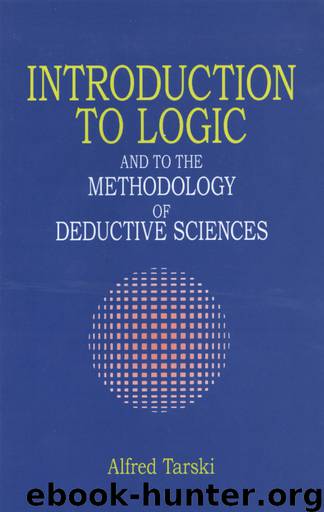Introduction to Logic and to the Methodology of Deductive Sciences by Alfred Tarski

Author:Alfred Tarski
Language: eng
Format: epub
Publisher: Dover Publications
Published: 2013-03-26T16:00:00+00:00
37. Model and interpretation of a deductive theory
As a result of a consistent application of the principles presented in the preceding section, deductive theories acquire certain interesting and important features which we shall describe here. Since the questions which we are going to discuss have a rather involved and abstract character, we shall try to elucidate them by means of a concrete example.
Suppose we are interested in general facts about the congruence of line segments, and we intend to build up this fragment of geometry as a special deductive theory. We accordingly stipulate that the variables “x”, “y”, “z”, … denote segments. As primitive terms we choose the symbols “S” and “≅”. The former is an abbreviation of the term “the set of all segments”; the latter designates the relation of congruence, so that the formula:
x ≅ y
is to be read as follows:
the segments x and y are congruent.
Further we adopt only two axioms:
AXIOM I.For any element x of the set S,x ≅ x(in other words: every segment is congruent to itself).
AXIOM II.For any elements x, y and z of the set S, ifx ≅ zandy ≅ z,thenx ≅ y(in other words: two segments congruent to the same segment are congruent to each other).
Various theorems on the congruence of segments may be derived from these axioms, for instance:
THEOREM I.For any elements y and z of the set S, ify ≅ z,thenz ≅ y.
THEOREM II.For any elements x, y and z of the set S, ifx ≅ yandy ≅ z,thenx ≅ z.
The proofs of these two theorems are very easy. Let us, for instance, sketch the proof of the first.
Putting in Axiom II “z” for “x” we obtain:
for any elements y and z of the set S, ifz ≅ zandy ≅ z,
thenz ≅ y.
In the hypothesis of this statement we have the formula:
z ≅ z
which, on the basis of Axiom I, is undoubtedly valid, and may hence be omitted. We thus arrive at the theorem in question.
In connection with these simple considerations we want to make the following remarks.
Our miniature deductive theory rests upon a suitably selected system of primitive terms and axioms. Our knowledge of the things denoted by the primitive terms, that is, of the segments and their congruence, is very comprehensive and is by no means exhausted by the adopted axioms. But this knowledge is, so to speak, our private concern which does not exert the least influence on the construction of our theory. In particular, in deriving theorems from the axioms, we make no use whatsoever of this knowledge, and behave as though we did not understand the content of the concepts involved in our considerations, and as if we knew nothing about them that had not been expressly asserted in the axioms. We disregard, as it is commonly put, the meaning of the primitive terms adopted by us, and direct our attention exclusively to the form of the axioms in which these terms occur.
This implies a very significant and interesting consequence. Let us replace the primitive
Download
This site does not store any files on its server. We only index and link to content provided by other sites. Please contact the content providers to delete copyright contents if any and email us, we'll remove relevant links or contents immediately.
| Algebra | Calculus |
| Combinatorics | Discrete Mathematics |
| Finite Mathematics | Fractals |
| Functional Analysis | Group Theory |
| Logic | Number Theory |
| Set Theory |
Modelling of Convective Heat and Mass Transfer in Rotating Flows by Igor V. Shevchuk(6391)
Weapons of Math Destruction by Cathy O'Neil(6148)
Factfulness: Ten Reasons We're Wrong About the World – and Why Things Are Better Than You Think by Hans Rosling(4694)
Descartes' Error by Antonio Damasio(3231)
A Mind For Numbers: How to Excel at Math and Science (Even If You Flunked Algebra) by Barbara Oakley(3221)
Factfulness_Ten Reasons We're Wrong About the World_and Why Things Are Better Than You Think by Hans Rosling(3199)
TCP IP by Todd Lammle(3137)
Fooled by Randomness: The Hidden Role of Chance in Life and in the Markets by Nassim Nicholas Taleb(3048)
Applied Predictive Modeling by Max Kuhn & Kjell Johnson(3019)
The Tyranny of Metrics by Jerry Z. Muller(3003)
The Book of Numbers by Peter Bentley(2912)
The Great Unknown by Marcus du Sautoy(2648)
Once Upon an Algorithm by Martin Erwig(2599)
Easy Algebra Step-by-Step by Sandra Luna McCune(2585)
Lady Luck by Kristen Ashley(2534)
Practical Guide To Principal Component Methods in R (Multivariate Analysis Book 2) by Alboukadel Kassambara(2497)
Police Exams Prep 2018-2019 by Kaplan Test Prep(2487)
All Things Reconsidered by Bill Thompson III(2358)
Linear Time-Invariant Systems, Behaviors and Modules by Ulrich Oberst & Martin Scheicher & Ingrid Scheicher(2334)
